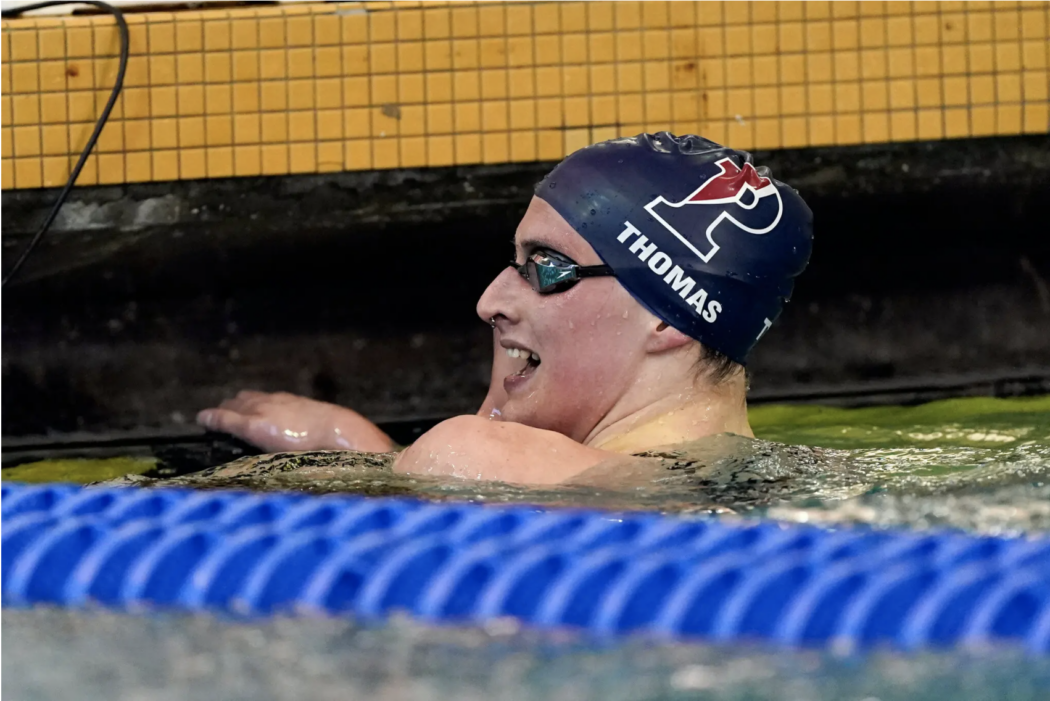Just keep swimming … well, that is unless you’re an openly transgender woman competing at the 2022 NCAA Division I Women’s Swimming and Diving championships. Lia Thomas, a swimmer at the University of Pennsylvania, represented the UPenn Quakers just weeks ago, but the controversy surrounding the championship meet is far from resolved.
Thomas won first place in the women’s 500 freestyle with a time of 4:33:24, making her the first known transgender woman to win a Division I NCAA championship title. She also earned eighth place in the women’s 200 freestyle. The University of Virginia’s Emma Weyant, an Olympic silver medalist in the 500 freestyle, placed second with a time of 4:34:99. Erica Sullivan, who’s also an Olympic silver medalist, represented the University of Texas and came in third place with a time of 4:35:92.
These winning times are not what’s caused much of the controversy surrounding Lia Thomas, but rather the NCAA regulations that allow her to compete against her cisgender female counterparts who feel she has an unfair advantage. Competitors, parents and even entire teams are voicing their opinions against the NCAA and Lia Thomas. Many are questioning the fairness in women’s sports when non-cisgender women are permitted to compete.

Current NCAA Policy
Before examining the gray areas of all of this, it’s important to understand the current NCAA policies in regard to transgender participation in sports. The policy was updated in January 2022 and is designed to align with similar changes made by both the United States Olympic and Paralympic Committee and the International Olympic Committee. The updated policies went into effect immediately.
The NCAA Board of Governors voted in favor of a “sport-by-sport” approach which states that transgender participation is determined by each respective sport’s governing body. More specifically, the policy requires that a transgender athlete’s testosterone levels are documented beginning four weeks before their sport’s championship selection begins. They must also document levels at the beginning of their competition season and provide second documentation six months after the first. Failure to comply with NCAA guidelines or the presence of testosterone levels that exceed limits — in this case, levels that are too high for a woman to compete — would result in ineligibility.
In the case of Lia Thomas, she was fully compliant with these policies and even took time off from swimming to ensure that she was following the aforementioned guidelines for competition. So, what’s the problem then?
Breaking Down the Controversy
The need for fairness and an equal playing field in sports, especially for women, is reflective of the progress we’ve made in the world of sports over the years. It’s the reason why many women have been able to break through barriers and claim their spots on podiums at various levels of competition when they may not have otherwise stood a chance against their male counterparts.
For decades, equality and fairness in women’s sports has been achieved by relying on the biological differences between men and women. However, within both men’s and women’s sports, we’ve seen variation in athletes on a biological level.
Take Michael Phelps, for example. One of the most decorated Olympic athletes of all time, Phelps has numerous biological advantages over his competition, including his disproportionately long torso compared to his “short” legs and his extra-long wingspan, which is three inches longer than his height. These two factors alone allow him to propel through the water more swiftly than his competition. His body also produces just half the lactic acid of his competitors which significantly reduces muscle soreness/ fatigue and overall recovery time. This gives him a significant, biological advantage in terms of his ability to train harder and longer with a much shorter recovery time.
On the women’s side of things, Caster Semenya, a middle-distance runner from South Africa is another example of variation among top athletes. She’s the winner of two Olympic gold medals in the women’s 800-meter as well as three World Championships in the same event. But more than her achievements, Semenya is known for her unusually high testosterone levels that are attributed to her being born intersex — when a person is born with reproductive or sexual anatomy that doesn’t fit within the typical definitions of male or female. However, she was raised female, is legally female and identifies as such. Many argue that Semenya’s high levels of testosterone provide her with an unfair advantage in the world of women’s sports.

What Does This Mean?
Regardless of differing opinions, both of these top athletes represent outliers when compared to their competitors and even more so when compared to the average person.
Why is Lia Thomas perceived as such a threat to what some refer to as “biological women” in sports if she isn’t winning by large margins or even setting NCAA records? Many have claimed that her advantage of being assigned male at birth has skyrocketed her to the top, however, she doesn’t even come close to crushing current NCAA record-holders Katie Ledecky and Missy Franklin.
Katie Ledecky, for those who don’t know, is a seven-time Olympic gold medalist and 15-time world championship gold medalist. She is the current NCAA record holder in the 500 freestyle with a time of 4:24:06 compared to Thomas’ winning time of 4:33:24. Missy Franklin is a two-time Olympian and a five-time Olympic gold medalist who is the current NCAA record holder in the 200 freestyle with a time of 1:39:10 compared to Thomas’ 1:43:40, which earned her an eighth-place finish.
Why Does It Matter?
Athletic performance, as many high-level athletes can attest, is influenced by hormones, but also by coaching, training, resources, equipment and many other factors. To say that athletic performance is only influenced by hormones is an inaccurate conclusion. The sports world has been able to uphold a “separate but equal” framework based on the notion of biological difference with the intent of creating more opportunities for women in sport. While there are certainly biological differences between males and females, there are also societal and cultural factors that influence the extent of which these differences exist.
The questions surrounding Lia Thomas’ eligibility to compete as a woman are hardly about her biology, but rather the larger issues of a situation riddled with complication and nuance.
Can separate ever be equal? How do we, as a society, define gender? Can barring transgender women from competing in women’s sports create fairness and opportunity for all women when it is not inclusive of all women? Further, who gets to decide what is woman enough? Would this issue be the same, or even exist if the roles were reversed — if it were a transgender man who was assigned female at birth but competed against cisgender men? Finally, should any person have to choose between something they love and the ability to fully live and exist as themselves?
While there may not be clear answers to any of these questions, it’s important to recognize that many arguments both against and in support of Lia Thomas are highly reductive and treat the situation as if it were black and white. At the end of the day, there is no one that knows Lia Thomas’ identity better than she does. But a critical and necessary part of fairness and equality for women is the inclusion of all women.
Do research. Ask questions. Think critically. Listen to understand. Our collective progress depends on it.
Tweet us, @VALLEYmag, on Twitter and tell us your thoughts!





